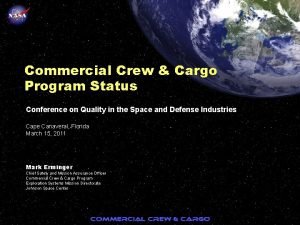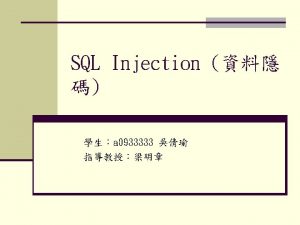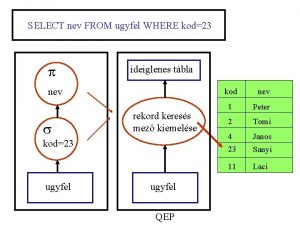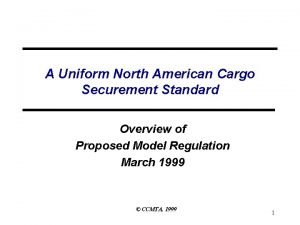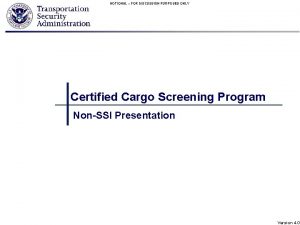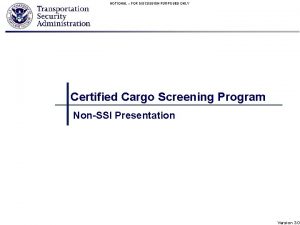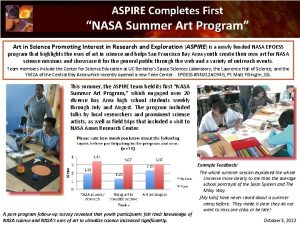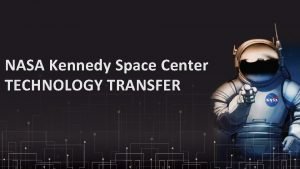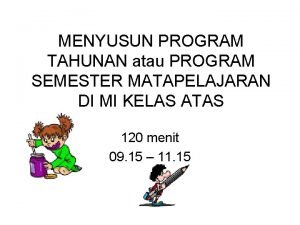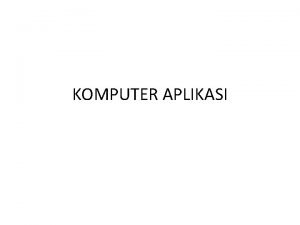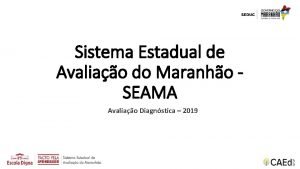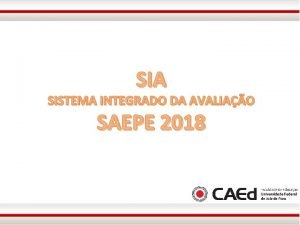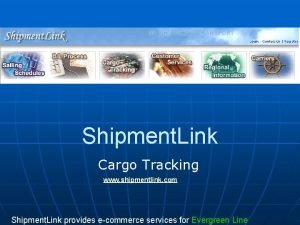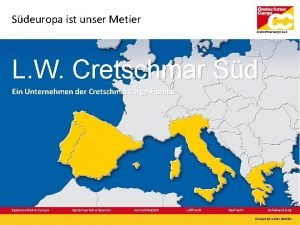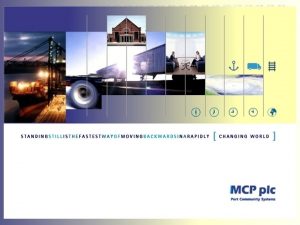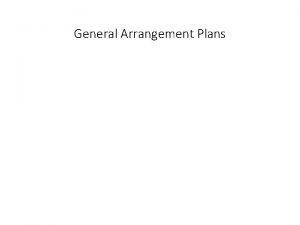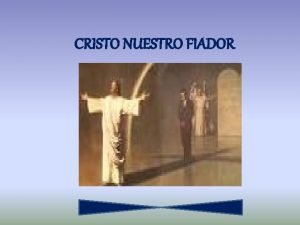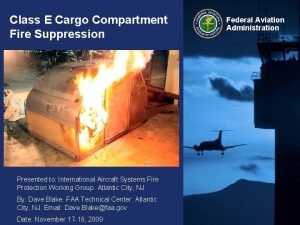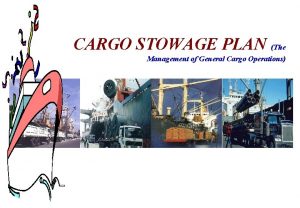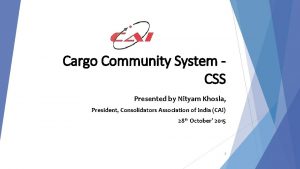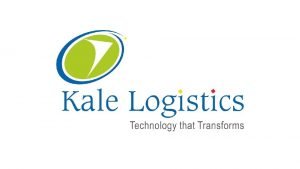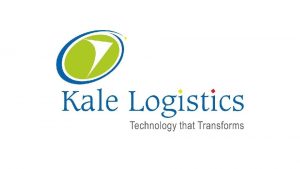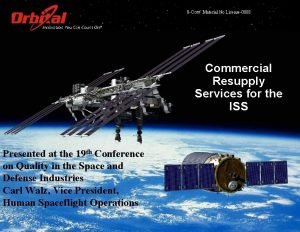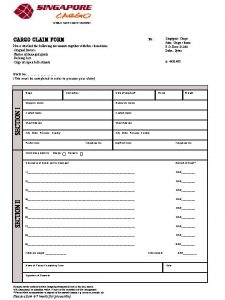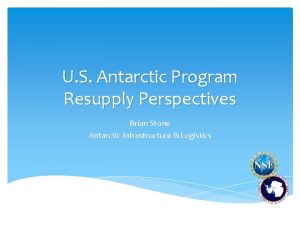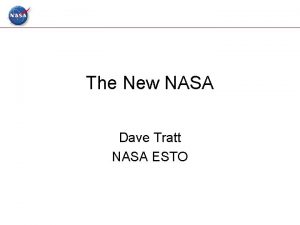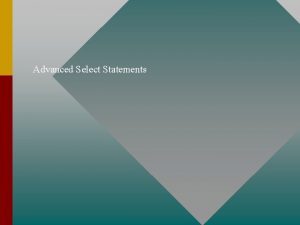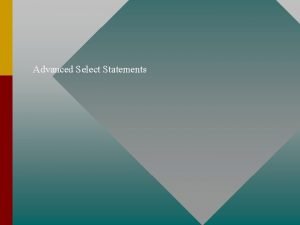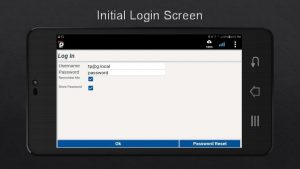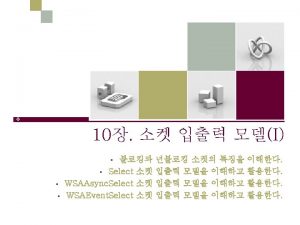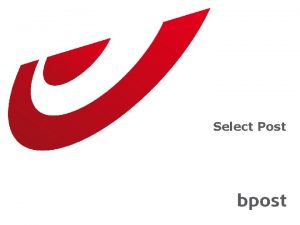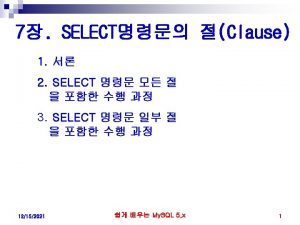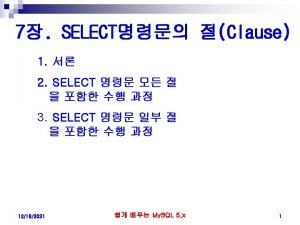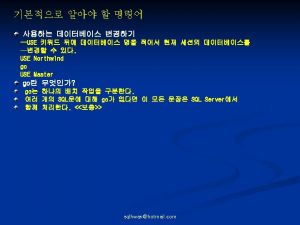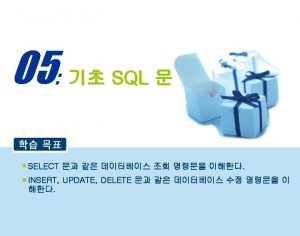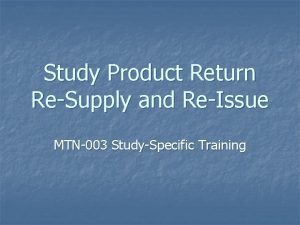NASA Commercial Cargo Program Cargo Resupply Service1 Select




































- Slides: 36

NASA Commercial Cargo Program Cargo Resupply Service-1 Select Image Reference Information

Commercial Cargo Program - Page 1 of 3 q NASA’s Commercial Crew and Cargo Program Office (C 3 PO) established a two -phased approach to implement its International Space Station (ISS) logistics strategy after the Shuttle was retired providing an opportunity for commercial space transportation services. - C 3 PO is responsible for challenging private industry to establish capabilities and services that open new space markets while meeting the logistics transportation needs of the ISS. - Commercial partners can serve existing markets and develop new markets, launching a new era for commercial space. q Commercial Cargo Program - Commercial Orbital Transportation Services (COTS) Under COTS, NASA helped industry develop and demonstrate its own crew cargo space transportation capabilities. -- Industry lead and directed its own efforts with NASA providing technical and financial assistance. -- NASA invested approximately $800 M from 2006 thru 2012 in cargo space transportation flight demonstrations. --- NASA payments were made only upon completion of progress milestones by its industry partners. - ISS Commercial Resupply Services - Phase 1 (CRS-1) The government conducted a competitive procurement for cargo services to support the ISS. -- On December 23, 2008, NASA entered into contracts with Orbital Sciences Corporation (Orbital) and Space Exploration Technologies (Space. X) to utilize their COTS cargo vehicles, Cygnus and Dragon, respectively, for cargo delivery to the ISS.

Commercial Cargo Program - Page 2 of 3 q Commercial Cargo Program - ISS Commercial Resupply Services - Phase 2 (CRS-2) NASA posted a Request for Information (RFI) about a possible follow-on to the current Commercial Resupply Services (CRS-1) to the International Space Station (ISS) on February 21, 2014. -- An “Industry Day” set of meetings was held in Houston on April 10, 2014 where seven highlevel requirements for the second Cargo Resupply Services contract solicitation were disclosed to parties who may be interested in contracting with the government to supply “nonscheduled chartered freight air transportation” resupply services to the ISS in the 2015 to 2024 time period. -- Capabilities required by the ISS in the RFI included: delivery of pressurized and unpressurized cargo, return and disposal of pressurized cargo, disposal of unpressurized cargo, and ground support services for the end-to-end resupply mission. - NASA released a Request for Proposals (RFP) for CRS-2 on September 26, 2014. -- Under the RFP, NASA intends to award contracts with one or more companies for six or more flights per contract. -- The contracted services would include logistical and research cargo delivery and return to and from the space station through fiscal year 2020, with the option to purchase additional launches through 2024. -- Proposals were due November 14, 2014 and NASA anticipated making a selection in April 2015. -- Five companies are known to publicly state they submitted proposals to NASA: Space. X, Orbital ATK, Boeing, Sierra Nevada Corporation, and Lockheed Martin. --- Lockheed Martin announced they were competing in March 2015.

Commercial Cargo Program - Page 3 of 3 q Commercial Cargo Program - ISS Commercial Resupply Services - Phase 2 (CRS-2) -- On November 5, 2015, NASA stated it would announce the award of new contracts for CRS -2 no later than January 30, 2016. --- The notice said the delay allowed additional time for NASA to assess proposals. -- Industry sources have said Lockheed Martin’s CRS-2 concept was eliminated from the competition earlier in 2015, but the company has not addressed the reports. -- NASA has also eliminated an uncrewed version of Boeing’s human-rated CST-100 Starliner capsule from the CRS-2 competition. -- On January 14, 2016, NASA announced the contract award winners for CRS-2 phase of the agency’s ongoing partnership with commercial companies for cargo resupply of the ISS starting in 2019; the three winners were: --- Orbital ATK and Space. X to continue flying their Dragon and Cygnus vehicles. --- Sierra Nevada Corporation to fly it’s Dream Chaser mini-Shuttle in an unmanned cargo resupply configuration. ---- A Dream Chaser manned configuration had been developed to transport/return crew members to/from the ISS.

Credit: NASA

Commercial Resupply Services - Phase 1 (CRS -1) Space X Orbital Select Image Credit: NASA selects Space. X to resupply the ISS for a minimum of 12 flights. Credit: NASA selects Orbital to resupply the ISS for a minimum of 8 flights.

Dragon Spacecraft Cargo Configuration Nose Cap Spacecraft Unpressurized Cargo Forward Hatch ISS Common Berthing Mechanism Pressurized Cargo Credit: Space. X Trunk Solar Array (Stowed) The Dragon spacecraft cargo configuration is comprised of 3 main elements: 1) Nose Cap - protects the vessel and the ISS common berthing mechanism during ascent and jettisoned after stage separation; 2) Spacecraft - houses the pressurized cargo as well as the service section containing avionics, the RCS system, parachutes, and other support subsystems; 3) Trunk - provides for the stowage of unpressurized cargo and will support Dragon’s solar arrays and thermal radiators. The thermal radiators are not shown.

Dragon Spacecraft The Spacecraft Engineering Model (left) is shown at the Space. X, Hawthorne, CA facility. The model is a manufacturing pathfinder, made just as the production flight units. This model and others were used for splashdown and structural testing. The capsule is 20 ft in length with a maximum diameter of 12. 1 ft. The side hatch opening has a height of 26 in and the base is 29 in. The Nose Cap is located on top of the capsule and jettisoned after launch. The ablative thermal protection system is not shown. Credit: Space. X The Qualification Unit as seen at Hawthorne, CA After using it for ground tests, Space. X launched it into low Earth orbit on the maiden flight of the Falcon 9 rocket on June 4, 2010. Space. X used the launch to evaluate the aerodynamic conditions on the spacecraft and performance of the rocket. The spacecraft orbited the Earth over 300 times before decaying from orbit and reentering the atmosphere on June Credit: Space. X 29, 2010.

Demo Flight 2 Launch Second Stage On May 22, 2012, the Falcon 9 rocket lifted off from Launch Complex 40 at Cape Canaveral Air Force Station, FL successfully launching the unmanned Dragon into orbit on a test flight to deliver supplies to the ISS. The 1, 150 lbs of supplies included food, crew provisions, student-developed experiments, and computer equipment. First Stage Falcon 9 also carried small canisters filled with cremated remains that included Mercury astronaut Gordon Cooper, who died in 2004, and actor James Doohan, who portrayed chief engineer Montgomery "Scotty" Scott on the original Star Trek television series. James Doohan died in 2005. Dragon After separation from the rocket, Dragon released the aerodynamic shields over its solar panels before deploying the arrays to generate electricity. The approach to the ISS was slow and methodical. Several planned and unplanned pauses were made to make sure Dragon's abort system was operating, its LIDAR laser ranging sensors were working, and its thermal cameras were seeing their target properly. Credit: Space. X

Demo Flight 2 Capture and Berth to the ISS Credit: NASA On May 25, 2012, the Dragon cargo spacecraft was captured by the ISS’ 56 ft Canadarm 2 robotic arm. The robotic arm (left) is shown maneuvering Dragon into a position where it could be berthed to the ISS Harmony module. The Dragon cargo spacecraft (right) was joined using the active Common Berthing Mechanism (CBM) on the Harmony module in a similar fashion to the Japanese H-II Transfer Vehicle. The Dragon passive CBM was captured and drawn into the desired position by 4 Harmony capture latches and secured by 16 Harmony bolts. Credit: NASA

Demo Flight 2 ISS Operations and Return On May 26, 2012, Dragon’s hatch was opened. An ISS Expedition 31 crew member photographed the interior (left). The hatch is at the top and the supplies that have not been unloaded are shown supported inside the spacecraft. After the supplies were unloaded, the equipment to be returned to Earth was loaded. Credit: NASA After the hatch was closed, the robotic arm grappled Dragon, maneuvered the spacecraft a safe distance from the ISS and released it. The cargo ship was then de-orbited and returned safely to Earth landing 560 miles west of Baja California, Mexico (right) completing a feat never before achieved by private industry. A fleet of recovery vessels, staffed with Space. X engineers and divers, retrieved the capsule from the sea. Space. X plans to reuse Dragon on future ISS cargo missions. Credit: Michael Altenhofen/Space. X

Space. X CRS-1 Launch Manifest - Page 1 of 3 Program Launch Date or Target Vehicle NASA COTS - Demo Flight 1 Dec. 8, 2010 NASA COTS - Demo Flight 2 Duration Flight Objective or Summary Falcon 9/ Cape Dragon Canaveral 3. 3 hours Dragon spacecraft completed two 186 mile Earth circular orbits executing a series of maneuvers and systems checkouts that will be needed for an ISS rendezvous and docking. It was then deorbited and landed in the Pacific Ocean off of the coast of Baja California, Mexico where the capsule was recovered. May 22, 2012 Falcon 9/ Dragon Cape Canaveral 10 days Full cargo mission profile including mate to the ISS, resupply and cargo return. Oct. 7, 2012 Falcon 9/ Dragon Cape Canaveral 21 days The launch successfully placed Dragon on course for the first operational mission to the ISS, but an engine failure led to the demise of a secondary payload for Orbcomm, Inc. Dragon delivered 882 lbs to the ISS and returned about 1, 673 lbs. NASA Resupply March 1, Falcon 9/ to ISS - Flight 2 2013 Dragon Cape Canaveral 25 days After three-fourths of Dragon's thrusters failed to activate and engineers resolved the problem, the vehicle delivered 1, 869 lbs of supplies to the ISS. Dragon returned to Earth with about 2, 668 lbs of cargo inside the cabin. NASA Resupply to ISS - Flight 1 Launch Site Credit: Space. X

Space. X CRS-1 Launch Manifest - Page 2 of 3 Program Launch Date or Target Vehicle Launch Site Duration Credit: Space. X Flight Objective or Summary NASA Resupply Apr. 18, Falcon 9/ to ISS - Flight 3 2014 Dragon Cape 30 days Canaveral Dragon successfully delivered 5, 000 lbs of supplies and science experiments to the ISS, and returned with about 3, 500 lbs. NASA Resupply Sep. 21, Falcon 9/ to ISS - Flight 4 2014 Dragon Cape 34 days Canaveral 5, 000 lbs of cargo and science were delivered to the ISS by the spacecraft; it returned with about 3, 276 lbs. NASA Resupply Jan. 10, Falcon 9/ to ISS - Flight 5 2015 Dragon Cape 32 days Canaveral The spacecraft carried 5, 108 lbs of cargo to the ISS and returned with about 3, 700 lbs. Space. X also attempted to return its Falcon 9 first stage through the atmosphere and land on a floating platform. Many of the test objectives were achieved but it “landed hard. ” NASA Resupply Apr. 14, Falcon 9/ to ISS - Flight 6 2015 Dragon Cape 33 days Canaveral Dragon delivered 4, 387 lbs of cargo to the ISS, and returned more than 3, 000 lbs. The Falcon 9 booster landed on the floating platform, however it came down with too much lateral velocity, tipped over, and was destroyed.

Space. X CRS-1 Launch Manifest - Page 3 of 3 Program (1) Launch Date or Target Vehicle Launch Site Duration Credit: Space. X Flight Objective or Summary NASA Resupply to ISS - Flight 7 June 28, 2015 Falcon 9/ Dragon Cape Loss of Canaveral Mission Following a nominal liftoff, Falcon 9 experienced an overpressure event in the upper stage liquid oxygen tank approximately 139 seconds into flight, resulting in the loss of mission. The event was initiated by a flawed strut inside the second stage. The strut will be replaced on subsequent upper stages, and additional hardware quality audits throughout the vehicle have occurred. NASA Resupply to ISS - Flight 8 Feb. 7, 2016 Falcon 9/ Dragon Cape Not Canaveral Available Complete the 8 th planned operational cargo delivery mission to the ISS. NASA Resupply Mar. 21, Falcon 9/ to ISS - Flight 9 2016 Dragon Cape Not Canaveral Available Complete the 9 th planned operational cargo delivery mission to the ISS. NASA Resupply to ISS - Flight 10 Cape Not Canaveral Available Complete the 10 th planned operational cargo delivery mission to the ISS. June 10, 2016 Falcon 9/ Dragon Note: (1) The Manifest does not include all of the planned missions (blue); check http: //spaceflightnow. com/tracking/ for launch dates that are subject to change.

Cygnus Spacecraft Pressurized Cargo Module Service Module Credit: Orbital Under a three-year COTS cooperative agreement with NASA, Orbital Sciences Corporation developed the new space transportation system to demonstrate the capability to deliver supplies to the ISS. The COTS program involves the full-scale flight demonstration of a commercial cargo delivery system employing the new Antares medium-class launch vehicle, and the Cygnus spacecraft. The spacecraft is not required to return to the Earth. The first COTS demonstration mission to the ISS was launched from Pad 0 A, Wallops Island, VA on September 18, 2013.

Antares Test Launch Antares is a two-stage expendable launch vehicle with a 12. 8 ft diameter payload fairing Payload designed to provide access to space for Fairing medium-class payloads weighing up to 13, 492 lbs. It is designed to launch payloads into a Second variety of low inclination low-Earth orbits, and Stage sun-synchronous, geo-transfer and First interplanetary orbits. An object in a sun. Stage synchronous orbit ascends or descends over any given point of the Earth's surface at the same local mean solar time. The Antares development was funded by Orbital Sciences Corporation and the NASA Commercial Orbital Transportation Services program. The first Orbital Sciences’ Antares rocket is shown carrying the Cygnus Mass Simulator, located inside the payload fairing, during a test flight on April 21, 2013 from Wallops Island, VA. Credit: Orbital

Cygnus Demo Flight 1 Approaches/Berths to ISS Credit: Orbital The Demonstration Flight 1 Cygnus cargo spacecraft (left) approaches the ISS where the Canadarm 2 robotic arm prepares to capture the vehicle on September 29, 2013. The robotic arm then maneuvered Cygnus into a position where it was joined using the active Common Berthing Mechanism (CBM) on the Harmony module in a similar fashion to the Japanese H-II Transfer Vehicle. The Cygnus passive CBM was then captured and drawn into the desired position by 4 Harmony capture latches and secured by 16 Harmony bolts. The Demonstration Flight 1 Cygnus spacecraft is shown berthed to the Harmony module (right) where cargo is unloaded. The spacecraft can then be loaded with waste. After the Cygnus spacecraft is loaded, the robotic arm grapples the vehicle, maneuvers the spacecraft a safe distance from the ISS and releases it. The spacecraft will then de-orbit and burn-up when it enters Earth’s atmosphere. Credit: Orbital

Cygnus Demo Flight 1 Hatch Opened at ISS Credit: Orbital The ISS Expedition 37 crew opened the hatch between the ISS and Cygnus on September 30, 2013. The Cygnus spacecraft delivered 1, 543 lbs of non-critical cargo and supplies to the station that included crew provisions and science equipment. The Harmony module is shown with its hatch open and a duct in the lower left corner ventilating Cygnus. Straps are supporting two bags of equipment on the left and top inside Cygnus. Loose support straps are also seen inside the cargo carrier. On October 7, 2013, the crew completed unloading the cargo and had loaded the first layer of 2, 850 lbs of waste for disposal. Cygnus unberthed from the station and re-entered the atmosphere on October 23.

Enhanced Cygnus Spacecraft Credit: Orbital ATK Beginning with the fourth operational Cygnus mission, an enhanced spacecraft continued providing logistics services to the ISS after the Antares launch failure on October 28, 2014. The first Enhanced Cygnus was launched to the ISS using the Atlas V on December 6, 2015. Cygnus incorporated a larger pressurized cargo module than the spacecraft used in the first three Cygnus missions. The enhanced vehicle can carry an additional 1, 600 lbs of crew supplies, spares and scientific experiments to the ISS. The spacecraft also used a pair of 11 ft diameter lightweight ATK Ultraflex solar arrays. The arrays provide the same power as those used in the first three missions but with significantly reduced mass.

First Enhanced Cygnus Launched on Atlas V After the CRS-1 Flight 3 Antares rocket had a failure after liftoff on October 28, 2014 destroying the rocket and the Cygnus spacecraft, Orbital ATK announced Antares would be redesigned and Cygnus would be launched on two CRS-1 missions by the Atlas V. CRS-1 Flight 4 launched the first Enhanced Cygnus on the Atlas V (left) to the ISS from Launch Complex 41, Cape Canaveral Air Force Station, FL on December 6, 2015. Cygnus with a liftoff weight of 16, 517 lbs was the heaviest payload to be launched by an Atlas V rocket. A second Atlas V is scheduled to launch the CRS-1 Flight 5 Enhanced Cygnus to Credit: NASA the ISS on March 10, 2016. The Antares rocket with two new Russian RD-181 engines return-to-flight is scheduled to liftoff May 31, 2016 launching the CRS-1 Flight 6 Enhanced Cygnus to the ISS. Orbital ATK’s Enhanced Cygnus spacecraft is shown approaching the ISS (right) on December 9, 2015. Cygnus was grappled by the station’s robotic arm, visible in the lower right of the frame, and then berthed to the ISS. The photograph was taken by ISS Expedition 45 Commander Scott Kelly. Credit: NASA

Orbital CRS-1 Launch Manifest - Page 1 of 3 Program Launch Date or Target Vehicle Launch Site Credit: Orbital Time at the ISS Flight Objective or Summary Antares Test Flight April 21, 2013 Antares/ Wallops Cygnus Island, VA Mass Simulator Not Applicable The first launch of the Antares rocket reached orbit, and the upper stage successfully deployed a 8, 377 lb mass designed to simulate the flight characteristics of the Cygnus spacecraft. The vehicle reached a near-circular orbit with an average altitude of about 155 miles. NASA COTS - Demo Flight 1 Sep. 18, 2013 Antares/ Standard Cygnus Wallops Island, VA 35 days The first rendezvous of Cygnus and the ISS was delayed due to a GPS navigation software mismatch with the ISS but was successful. Cygnus was berthed to the ISS and delivered 1, 543 lbs to the ISS. 2, 850 lbs of waste was loaded and the vehicle re-entered the atmosphere and burned-up on Oct. 23. Antares/ Standard Cygnus Wallops Island, VA 37 days Cygnus successfully completed its first operational mission carrying 2, 780 lbs of cargo and science payloads to the ISS. It disposed of about 3, 250 lbs of unneeded items when it reentered the atmosphere east of New Zealand. NASA Resupply Jan. 9, to ISS - Flight 1 2014

Orbital CRS-1 Launch Manifest - Page 2 of 3 Program Launch Date or Target Credit: Orbital Vehicle Launch Site Time at the ISS Flight Objective or Summary NASA Resupply July 13, to ISS - Flight 2 2014 Antares/ Standard Cygnus Wallops Island, VA 31 days The spacecraft delivered 3, 669 lbs of cargo and science payloads to the ISS. Cygnus reentered the atmosphere with about 3, 550 lbs of disposable items. NASA Resupply Oct. 28, to ISS - Flight 3 2014 Antares/ Standard Cygnus Wallops Island, VA 0 days Antares launch attempt suffered an anomaly resulting in an explosion 15 seconds after launch. The failure originated in the turbopump of one of the booster’s AJ-26 main engines. Orbital Sciences plans to redesign the booster using two new Russian RD-181 engines. More than 5, 000 lbs of cargo and supplies, including research hardware, student experiments, spare parts, food and crew supplies, 32 nanosatellites and other gear, were lost in the mishap.

Orbital CRS-1 Launch Manifest - Page 3 of 3 Program (1) Launch Date or Target Credit: Orbital ATK Vehicle Launch Site Time at the ISS Flight Objective or Summary NASA Resupply Dec. 6, to ISS - Flight 4 2015 Atlas V/ Enhanced Cygnus Wallops Island, VA Not Available The first of two Enhanced Cygnus missions launched by the Atlas V before return-to-flight of Antares with new Russian engines. Delivered a total cargo, including packaging, of about 7, 745 lbs to the ISS. Cygnus reentered the atmosphere with about 3, 000 lbs of disposable items. NASA Resupply Mar. 10, to ISS - Flight 5 2016 Atlas V/ Enhanced Cygnus Cape Canaveral Not Available Launch the 5 th planned operational mission with the Enhanced Cygnus to the ISS using the second Atlas V. NASA Resupply May 31, to ISS - Flight 6 2016 Antares 230/ Enhanced Cygnus Cape Canaveral Not Available Launch the 6 th planned operational mission with the Enhanced Cygnus to the ISS using Antares with new engines. NASA Resupply Oct. 4, to ISS - Flight 7 2016 Antares 230/ Enhanced Cygnus Cape Canaveral Not Available Launch the 7 th planned operational mission with the Enhanced Cygnus to the ISS using Antares. Note: (1) The Manifest does not include all of the planned missions (blue); check http: //spaceflightnow. com/tracking/ for launch dates that are subject to change.

Reference Information - Page 1 of 2 q Images: NASA, Space. X, Orbital Sciences Corporation, Orbital ATK q Text: http: //www. nasa. gov/ http: //en. wikipedia. org/ https: //prod. nais. nasa. gov/ http: //procurement. jsc. nasa. gov/ http: //spacenews. com/ http: //www. spacex. com/ http: //spaceflightnow. com/ http: //www. nasaspaceflight. com/ http: //spacecraft. ssl. umd. edu/design_lib/ICES 01 -2435. ISS_CBM. pdf http: //spaceflight. nasa. gov/ http: //www. orbital. com/ http: //spacecraft. ssl. umd. edu/design_lib/ICES 01 -2435. ISS_CBM. pdf Special Delivery by Mark Carreau, Aviation Week & Space Technology; October 7, 2013; Volume 175, Number 35, page 27 - first delivery of cargo and supplies by the Orbital Cygnus to the ISS http: //www. ulalaunch. com/ http: //www. orbitalatk. com/

Reference Information - Page 2 of 2 q Text (Continued): http: //www. space. com/ http: //www. thalesaleniaspace-issmodules. com/cygnus End



History of Commercial Orbital Transportation Services q NASA explored a program for International Space Station (ISS) services in the mid 1990 s titled “Alternate Access. ” While NASA funded Alternate Access no further than preliminary studies, this program convinced numerous entrepreneurs that the ISS could emerge as a significant market opportunity. q After years of keeping orbital transport for human spaceflight in-house, NASA concluded that firms in a free market could develop and operate such a system more efficiently and affordably than a government bureaucracy. § In November 2005, Michael D. Griffin, the NASA Administrator, believed that when the engine of competition is engaged these services would be provided in a more cost-effective fashion than if the government would do it. He also believed that, with the advent of the ISS, there will exist for the first time a strong, identifiable market for “routine” transportation service to and from low Earth orbit, and this will be only the first step in what will be a huge opportunity for truly commercial space enterprise. § Furthermore, since such services were unavailable by the end of 2010 and NASA's own Crew Exploration Vehicle was not ready, NASA was forced to purchase Orbital Transportation Services on foreign spacecraft such as the Russian Federal Space Agency's Soyuz and Progress spacecraft, the European Space Agency's Automated Transfer Vehicle, or the Japan Aerospace Exploration Agency's H-II Transfer Vehicle. § NASA asserted that once Commercial Orbital Transportation Services (COTS) was operational, it would no longer procure Russian cargo delivery services. § COTS helped industry develop and demonstrate cargo space transportation capabilities. § ISS Commercial Resupply Services, Phase 1 (CRS-1) began commercial operational cargo flights to the ISS started in 2012 and continue until 2016. § ISS Commercial Resupply Services, Phase 2 (CRS-2) continues cargo flights from 2017 through 2024; as of December 2015, contract awards have not been announced.

Dragon Spacecraft - Page 1 of 2 q Space Exploration Technologies Corporation (Space. X) is an American space transport company founded by Pay. Pal co-founder Elon Musk in June 2002. It has developed the Falcon 1 and Falcon 9, both of which are partially reusable launch vehicles. Space. X is also developing the Dragon series of spacecraft orbited by Falcon 9 launchers. Space. X designs, tests and fabricates the majority of their components in-house, including the Merlin, Kestrel, and Draco rocket engines. Space. X is based in Hawthorne, CA. § On 18 August 2006, NASA announced that Space. X had won a Commercial Orbital Transportation Services contract worth $278 million to demonstrate cargo delivery to the International Space Station (ISS) with a possible option for crew transport. § In December 2008, NASA announced the selection of the Space. X Falcon 9 launch vehicle and Dragon spacecraft to resupply the ISS after the Space Shuttle retired. The $1. 6 billion contract represented a minimum of 12 flights. § In August 2015, modifications to the NASA 2008 Cargo Resupply Services, Phase 1 contract with Space. X changed the total missions to 15 to satisfy the ISS cargo needs into early 2018. q Dragon § A free-flying, reusable spacecraft developed by Space. X. Initiated internally by Space. X in 2005, the Dragon spacecraft consists of a pressurized capsule and unpressurized trunk used for Earth to low Earth orbit transport of pressurized cargo, unpressurized cargo, and/or crew members. § For cargo launches, the inside of the spacecraft is outfitted with a modular cargo rack system designed to accommodate pressurized cargo in standard sizes and form factors.

Dragon Spacecraft - Page 2 of 2 q Dragon (Continued) § Characteristics/capabilities include: - Overall length is 20 ft and maximum diameter is 12. 1 ft - Fully autonomous rendezvous with manual override capability in crewed configuration - 13, 228 lbs payload up-mass to LEO; 6, 614 lbs payload down-mass to Earth - Payload Volume: 245 cubic ft pressurized, 490 cubic ft unpressurized - Two-fault tolerant avionics system with extensive heritage - Reaction control system with 18 MMH/NTO (monomethylhydrazine/nitrogen tetroxide) thrusters, designed and built in-house; these thrusters are used for both attitude control and orbital maneuvering - 2844 lbs of propellant supports a safe mission profile from sub-orbital insertion to ISS rendezvous to re-entry - Integral common berthing mechanism (CBM), with LIDS or APAS support, if required - Designed for water landing under parachute for ocean recovery - Lifting re-entry for landing precision and low-gravity - Ablative, high-performance heat shield and sidewall thermal protection

Falcon 9 Launch Vehicle - Page 1 of 2 q Falcon 9 - Space. X is developing a family of launch vehicles that will provide light, medium and heavy lift capabilities to launch spacecraft into any altitude and inclination, from low Earth to geosynchronous to planetary missions. Falcon 1 was the first privately developed liquid fuel rocket to achieve Earth orbit. It is a small, partially reusable rocket capable of placing 1480 lbs into low Earth orbit. It also functioned as a test bed for developing concepts and components for the larger Falcon 9. Like Falcon 1, Falcon 9 is a two stage, liquid oxygen and rocket grade kerosene (RP-1) powered launch vehicle. It is in the Evolved Expendable Launch Vehicle (EELV) class with a 17 ft diameter payload fairing. It delivers medium sized payloads into low Earth, geosynchronous, or transfer orbits. § First Stage - The Falcon 9 tank walls and domes are made from aluminum lithium alloy. Space. X uses an all friction stir-welded tank. Like Falcon 1, the interstage, which connects the upper and lower stage for Falcon 9, is a carbon fiber aluminum core composite structure. The separation system is a larger version of the pneumatic pushers used on Falcon 1. - Nine Space. X Merlin engines power the Falcon 9 first stage with 125, 000 lbs sea level thrust per engine for a total thrust on liftoff of just over 1. 1 million lbs. After engine start, Falcon is held down until all vehicle systems are verified to be functioning normally before release for liftoff. - Space. X is developing a privately funded, re-useable launch system. Currently, the technology is under development for the first stages of the Falcon family of rockets. -- The first successful controlled landing of an orbital rocket first stage on the ocean surface was achieved in April 2014. -- In January 2015, a test flight attempted to land the Flight 5 operational mission by returning the first stage to a floating landing platform. Although the Falcon 9 booster was guided to the target, the landing was unsuccessful. -- Space. X successfully landed the Falcon 9 booster on Landing Site 1 at Cape Canaveral Air Force Station, FL, and launched 11 Orbcommunication satellites on December 21, 2015.

Falcon 9 Launch Vehicle - Page 2 of 2 § Second Stage - The second stage tank of Falcon 9 is a shorter version of the first stage tank and uses most of the same tooling, material and manufacturing techniques. This results in significant cost savings in vehicle production. - A single Merlin engine powers the Falcon 9 upper stage with an expansion ratio of 117: 1 and a nominal burn time of 345 seconds. For added reliability of restart, the engine has dual redundant pyrophoric igniters. § Space. X Merlin Engine - The main engine, called Merlin, was developed internally at Space. X, but draws upon a long heritage of space proven engines. The pintle style injector at the heart of Merlin was first used in the Apollo Moon program for the lunar module landing engine. - Propellant is fed via a single shaft, dual impeller turbo-pump operating on a gas generator cycle. The turbo-pump also provides the high pressure kerosene for the hydraulic actuators which then recycles into the low pressure inlet. This eliminates the need for a separate hydraulic power system and means that thrust vector control failure by running out of hydraulic fluid is not possible. A third use of the turbo-pump is to provide roll control by actuating the turbine exhaust nozzle (on the second stage engine). § Characteristics/capabilities include: - Length: 180 ft, Width: 12 ft - Mass (to low Earth orbit, 17. 1 ft fairing): 735, 000 lbs - Mass (to geosynchronous transfer orbit, 17. 1 ft fairing): 733, 800 lbs - Thrust (vacuum): 1, 110, 000 lbs

Cygnus Advanced Maneuvering Spacecraft - Page 1 of 2 q Orbital Sciences Corporation (Orbital), founded in 1982, specializes in satellite launch and manufacture. Products include: space launch vehicles, missile defense systems, satellites and related systems, advanced space systems, and space technical services. Its headquarters was located in Loudoun County, VA. § Orbital initially developed the Antares launch vehicle and Cygnus spacecraft for the NASA Commercial Orbital Transportation Services (COTS) development and demonstration program. Orbital used Cygnus to perform the International Space Station (ISS) resupply flights under the Commercial Resupply Service, Phase 1 (CRS-1) contract. In December 23, 2008, NASA authorized the contract for 8 missions between 2011 and 2015 carrying approximately 44, 092 lbs of cargo to the ISS as well as disposal of ISS waste. § The merger of Orbital Sciences Corporation and Alliant Techsystems Incorporated (ATK) into Orbital ATK began operations on February 10, 2015. - Orbital ATK headquarters is located in Dulles, VA. § In August 2015, modifications to the NASA 2008 CRS-1 contract with Orbital ATK changed the total missions to 10 to satisfy the ISS cargo needs into early 2018. q Cygnus is a 10. 1 ft in diameter spacecraft with two basic components: the Pressurized Cargo Module (PCM) and the Service Module (SM). § The PCM is designed to transport the cargo that includes equipment, spare parts, scientific experiments and other items to the ISS. - It is based on the ISS Multi-Purpose Logistics Module and built by Thales Alenia Space Italia.

Cygnus Advanced Maneuvering Spacecraft - Page 2 of 2 q Cygnus (Continued) § Cygnus does not provide return capability but can be loaded with obsolete equipment and trash for destructive reentry similar to the Russian Progress vehicles. - A formerly planned variant of Cygnus would have replaced the PCM with an unpressurized cargo module based on NASA's Ex. PRESS Logistics Carrier and could have been used to transport unpressurized cargo such as ISS Orbital Replacement Units. § The SM is manufactured by Orbital and based on their STAR spacecraft bus as well as components from the development of the Dawn spacecraft. - Propulsion is provided by thrusters using the hypergolic propellants hydrazine and nitrogen tetroxide. - The two solar arrays produces up to 4 KW of electrical power. § Information/characteristics/capabilities include: - Service Module -- Design, integration and test performed by Orbital -- Heritage: STAR Bus, GEOStar, LEOStar -- Power Generation: 2 solar arrays -- Power Output: 3. 5 KW (sun-pointed) -- Propellant: Dual-mode N 2 H 4/MON-3 or N 2 H 4 - Pressurized Cargo Module -- Design, integration and test performed by Thales Alenia Space Italia (sub-contractor) -- Heritage: ISS Multi-Purpose Logistics Module -- Total Cargo Mass: 4, 400 lbs (standard); 6, 000 lbs (enhanced) -- Pressurized Volume: 667 cubic ft/925 cubic ft -- Berthing at ISS: Node 2 Common Berthing Mechanism

Antares Launch Vehicle - Page 1 of 2 q Antares - The Mid-Atlantic Regional Spaceport, part of the Wallops Flight Facility, VA, is the initial launch site for Antares, known during development as Taurus II. Launch pad 0 A, the former launch pad for the Conestoga rocket has been modified to handle Antares. - The launch vehicle is also compatible with the Western Range at Vandenberg Air Force Base, Eastern Range at Cape Canaveral Air Force Station and Kodiak Launch Complex. § First Stage - Uses RP-1 (kerosene) and liquid oxygen (LOX) as propellants, powering two NK -33 -derived engines (supplied by Aerojet as AJ-26 engines). - In March 2010, Orbital Sciences and Aerojet successfully completed test firings of the NK-33 engines. - Since Orbital Sciences has little experience with large liquid stages and LOX propellant, some of the first stage was contracted to Yuzhnoye SDO, designers of the Zenit series. - The core tank assembly is provided by Yuzhnoye and includes: propellant tanks, pressurization tanks, valves, sensors, feed lines, tubing, wiring and other associated hardware. - Second Stage - Comprised of the ATK Castor 30 solid stage with electromechanical thrust vector control. - It has been developed by ATK as a derivative of the Castor 120. On December 10, 2009, ATK test fired their Castor 30 motor for use as the Antares second stage. § Characteristics/capabilities include: - Payload capacity to low Earth orbit: 11, 000 lbs - 12. 8 diameter payload fairing, and first and second stages - Height: 133 ft - Mass: 530, 000 lbs

Antares Launch Vehicle - Page 2 of 2 q Antares (Continued) § The CRS-1 Flight 3 Antares rocket had a failure moments after liftoff on October 28, 2014 at Wallops Island, VA destroying the rocket and the Cygnus spacecraft, and damaging the launch pad. § Orbital ATK investigation identified a manufacturing defect inside a Russian AJ 26 engine turbopump as the most likely cause of the failure, and a team of NASA engineers identified three credible technical root causes which could have resulted in the failure. § Orbital ATK announced that it is taking maximum advantage of the technical recommendations of NASA and implementing them into the current program; the plan is: - The Cygnus spacecraft would launch to the ISS twice on United Launch Alliance Atlas V rockets. -- On December 6, 2015, an Atlas V successfully launched the first Enhanced Cygnus to the ISS during CRS-1 Flight 4. -- On March 10, 2016, an Atlas V rocket is scheduled to launch the CRS-1 Flight 5 Enhanced Cygnus to the ISS. - The Antares 230 rocket’s return-to-flight with two new Russian RD-181 engines is scheduled for May 31, 2016 launching the CRS-1 Flight 6 Enhanced Cygnus to the ISS. - The switch to the more powerful Atlas V and Antares 230, along with the Enhanced Cygnus’ increased volume, will enable Orbital ATK to cover their initial CRS-1 contracted payload obligation by Flight 7.
 Commercial crew and cargo program
Commercial crew and cargo program Noncommercial food service
Noncommercial food service Kahalagahan ng tugmaang pambata
Kahalagahan ng tugmaang pambata Nasa www.nasa.gov
Nasa www.nasa.gov Select * from select
Select * from select Ameadmin
Ameadmin Select * from select
Select * from select Select * from select
Select * from select North america cargo securement
North america cargo securement Tsa certified cargo screening program
Tsa certified cargo screening program Tsa certified cargo screening program
Tsa certified cargo screening program Nasa art program
Nasa art program Nasa technology transfer program
Nasa technology transfer program Gulf power energy select
Gulf power energy select Differences between sequential and event-driven programming
Differences between sequential and event-driven programming Perangkat lunak dalam komputer dinamakan
Perangkat lunak dalam komputer dinamakan Program tahunan adalah
Program tahunan adalah Microsoft excel merupakan program dari aplikasi
Microsoft excel merupakan program dari aplikasi Microsoft excel
Microsoft excel Langkah langkah memulai microsoft word
Langkah langkah memulai microsoft word What is frustrated cargo
What is frustrated cargo Avaliação seama 2021
Avaliação seama 2021 Saepe inscrição colaborador
Saepe inscrição colaborador Shipment link container tracking
Shipment link container tracking Cretschmar cargo mitarbeiter
Cretschmar cargo mitarbeiter Modelos de desenho de cargos
Modelos de desenho de cargos Maritime cargo processing plc
Maritime cargo processing plc General arrangement plan
General arrangement plan Cristo pago por nuestros pecados
Cristo pago por nuestros pecados Class e cargo compartment
Class e cargo compartment Airfreight booking software
Airfreight booking software Stowage plan kapal
Stowage plan kapal Cargo kult
Cargo kult Bag cargo adalah
Bag cargo adalah Cargo community systems
Cargo community systems Bol in trucking
Bol in trucking Cargo community system
Cargo community system
